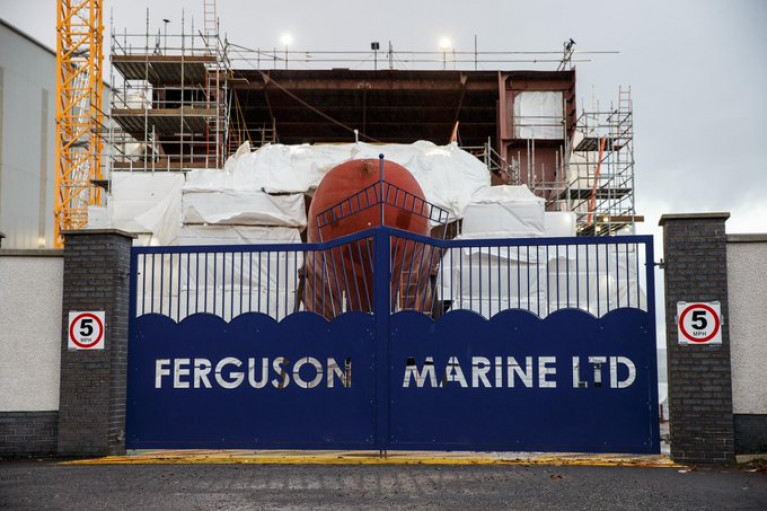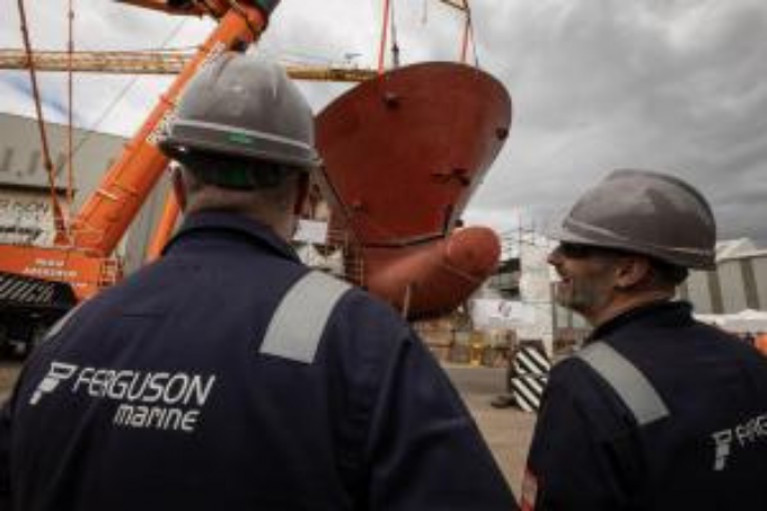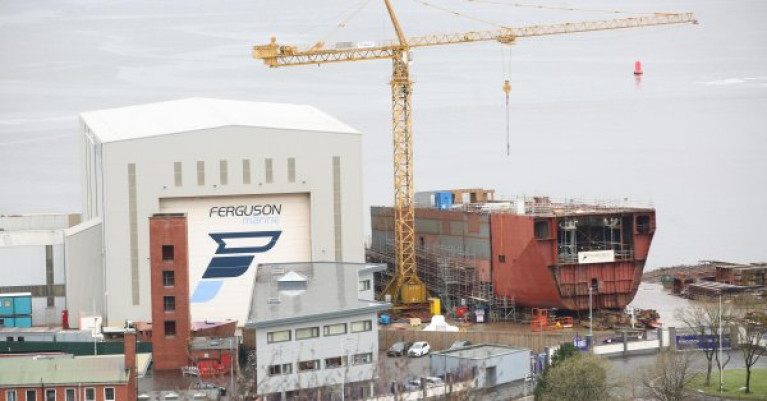Displaying items by tag: Ferguson Marine
Clydeside Shipyard Delayed Ferries for CalMac 'to Carry Fewer Passengers than First thought'
The considerably delayed newbuilds for Scotland ferry operator, Caledonian MacBrayne (CalMac) which are being built at Ferguson Marine shipyard, Port Glasgow, will it has emerged carry fewer passengers than first envisioned.
As STV reports, the reduction in passenger capacity of the leadship twins, Glen Sannox and recently named Glen Rosa, is in response to safety certification measures as required by the regulator, the Maritime and Coastguard Agency (MCA).
This will see each ferry with a maximum carrying capacity of 1,000 reduced to 852 passengers, a difference of 148 in the original design of the newbuilds, with the first the Glen Sannox Afloat highlights was due to enter service in 2018.
Chief executive of the Scottish Government-owned shipyard, David Tydeman said the cost of the newbuilds has risen further, see previous coverage.
In a letter sent last week to MSP’s, he said Calmac and the agency Caledonian Maritime Assets Ltd (CMAL) were considering a maximum capacity of 852 passengers to accommodate the required number of stairwells and passageways.
On Tuesday, transport minister Fiona Hyslop said CMAL would only take delivery of the newbuilds, once they had been signed off by the MCA, in addition to the regulator, the class society, which surveys ships.
The minister told the Scottish Parliament that all systems including the Liquid National Gas (LNG) propulsion system will need to be completed, something which will require special pipework.
More here on the ongoing ferry story.
As the shipyard ferry fiasco in Scotland continues, ministers in Edinburgh have come under fire as new estimates suggest the cost of the dual-fuel powered newbuilds could reach £400m.
The figure for the CalMac ferries, does not include the millions pumped into the nationalised shipyard Ferguson Marine to keep it operating, amounts to over four times the £97m contract cost for the two lifeline ferries to serve on Arran on the Forth of Clyde.
Both newbuilds, Glen Sannox and the recently named twin, Glen Rosa following a public vote, still await delivery at the Inverclyde shipyard, downriver of Glasgow.
Chief executive of Ferguson Marine, David Tydeman indicated that it will cost an extra £240 million to build the ferries on top of what was previously spent before the nationalisation of the shipyard took place in 2019.
As The Herald, which more on the story, reports that £83.25 million was spent on the ferries prior to the Scottish Government taking control of the shipyard firm with an additional £45 million on loan.
In Scotland the ferry bosses which own Caledonian MacBrayne (CalMac) vessels, have revealed the name of the second delayed newbuild under construction by Ferguson Marine shipyard on the Clyde.
The long-delayed ferry which for years has only been known as Hull 802, is to be named the Glen Rosa following a list of selected names given in an online public vote.
Caledonian Maritime Assets Ltd (CMAL), the body which owns CalMac vessels as well as the port and harbour infrastructure, announced the name from the listed options: Glen Coy, Glen Rosa and Claymore.
In the public vote, nearly 5,000 people took part in the name the ferry competition.
Of the three names, Glen Rosa, which is Gleann Ruasaidh in Gaelic, was the public’s most popular, winning 52 per cent of all votes cast.
The dual-fuel powered ferries, each of 102m in length, were due to enter service in 2018 at a price of £97 million, however delays have led to spiralling costs which could amount to more than three times that figure.
More from The Scotsman on the 1,000 passenger newbuild.
The winning name Afloat adds refers to the glen near Goat Fell (874m) the highest point on Arran in the Firth of Clyde where the newbuild will also serve with twin Glen Sannox also being built at Ferguson Marine.
The ferries, each capable of carrying 127 cars or 16 HGVs, or a combination of both will operate on the Ardrossan-Brodick, Arran route.
They will operate on both liquefied natural gas (LNG) and marine diesel. LNG is significantly cleaner and has been adopted by ferry operators in northern Europe in response to tighter emissions regulations
Twin dual-fuel powered ferries being built at Ferguson Marine shipyard on the Clyde are facing further delays after demands for design changes by the safety regulator.
According to the Maritime and Coastguard Agency (MCA) doors will have to be modified and extra staircases installed on both the M.V. Glen Sannox and the unnamed Hull 802.
Both newbuilds, with around 1,000 passengers each, are to serve CalMac's Ardrossan-Brodick (Arran) route, were to have scheduled sea trials, however they will now be delayed until the first few months of 2024.
The Glen Sannox which was launched in 2018, is due to enter service on CalMac's busiest route, by the end of 2023 while the Hull 802 is not set to take to water with passengers until summer 2024.
Managing director of the Inverclyde shipyard, David Tydeman at Holywood, told the Scottish Parliament's transport committee that he hopes to reach a final agreement with the safety regulator within the next two weeks
.
STV News has more on this latest development affecting the timeframe of the newbuild's delivery into service.
In Scotland, ministers of the Government intend to return the troubled shipyard of Ferguson Marine to the private sector, a senior Scottish National Party minister has confirmed.
The SNP minister Neil Gray and Cabinet Secretary for Wellbeing Economy, Fair Work and Energy, said it was hoped the shipyard (located downriver of Glasgow at Port Glasgow) could become commercially successful again.
Ferguson Marine as Afloat has reported over the years, has been at the centre of controversy over the construction of two newbuild ferries for CalMac, a subsidiary of David MacBrayne Ltd, which is wholly owned by Scottish Ministers.
The first of the two newbuilds of around 5,000 gross tonnage, the Glen Sannox and an unnamed twin are substantially delayed and overbudget.
Each of the 102m ferries have a capacity for 1,000 passengers, 127 cars and 16 lorries that are to serve island communities and tourism.
In March a report by Audit Scotland had raised doubts over the long-term viability of the shipyard, which was to have completed building the first of the ferries in 2018 at the yard that in the following year was nationalised.
For more, The Scotsman reports.
New Clyde Ferry Is Hugely Delayed will Need Eight Weeks of Trials after Shipyard Completion – CalMac
Glen Sannox, the massively delayed Scottish ferry for operator CalMac, will need nearly two months of further tests before the 1,000 passenger capacity vessel can enter service on the Firth of Clyde.
In addition the duel-fuelled powered ferry which is to serve the Isle of Arran route, will also have to undergo "extensive” sea trials prior to completion by shipyard Ferguson Marine which John Swinney related to MSPs last week.
CalMac, has confirmed to The Scotsman, of the duration of the additional “familiarisation and network trials” that will be required before the hybrid newbuild will be able to operate on the Ardrossan-Brodick route.
Such trials of the 102m newbuild is likely to increase the pressure to have the new ferry ready for next year’s summer season after Deputy First Minister announced a further delivery delay at the shipyard owned by the Scottish government.
The delay at the Clydeside shipyard, is now to see the 16.5 knot ferry enter from May to this autumn, if not the end of the year.
A twin of Glen Sannox, the as-yet unnamed hull (#802) to operate between Uig, Harris and North Uist, will also be delayed, from March 2024 to “late summer”, if not the end of the year.
According to spending watchdog, Audit Scotland they expect the project to cost at least £293 million – this amount is three times the cost of the original contract and as Afloat reported the Glen Sannox was due to enter service in 2018.
More here on the shipbuilding story.
Scottish Shipyard Ferries for CalMac Delayed Yet Again and Now Three Times Over Budget
Shipyard chief executive David Tydeman told MSPs in a letter on Wednesday that the two ferries, which are five years late, would cost up to £209.6 million to complete compared to the previous estimate of up to £122m.
According to The Scotsman, that would mean a total cost of around £300m, including some £83m previously spent, compared to the original contract of £97m.
A damning report into the fiasco by public spending watchdogs Audit Scotland in March had estimated the final cost would be at least £240m.
Mr Tydeman said the second ferry, known as hull 802, is not now expected to be handed over until the first quarter of 2024 compared to the previously scheduled timescale of between October and December 2023.
It is being built at the Port Glasgow yard for the Skye-Harris-North Uist triangle route.
Mr Tydeman also said in the update to the Scottish Parliament’s net zero, energy and transport committee that there was a “one to two month worst case slippage in final handover” of Glen Sannox, or 801 – the first vessel (for Arran route on the Forth of Clyde).
More here on the Clydeside shipyard.
The First Minister of Scotland, Nicola Sturgeon has said she will “not apologise” for decisions taken with the aim of saving the shipyard Ferguson Marine.
The Clyde yard was nationalised in 2019, but island communities are still awaiting the delivery of two new ferries (see CalMac naming story), with the project facing delays as well as being over-budget.
Earlier this week, businessman Jim McColl hit out at the First Minister over her claim that the yard would have closed had the Government not intervened.
McColl accused the SNP leader of lying about the number of jobs that were saved at the yard at the time and said there was “no danger” of the yard closing at the time.
The First Minister, however, has defended the actions taken by her government, as she pointed to 400 workers who are currently employed at the yard.
Scottish Conservative leader Douglas Ross raised the issue at First Minister’s Questions on Wednesday – being held a day early at the Scottish Parliament due to the local election on Thursday.
STV News has further coverage on the shipyard issue raised at Holyrood, the Scottish parliament.
Clydeside shipyard Ferguson Marine announced on Monday, the completion of a major milestone in the build of one of the dual fuel ferries currently under construction.
Hull 802, as the vessel is currently known, was fitted with its large bow unit which is the largest single unit added to the ferry’s steel hull, completing the bow structure.
This week will mark a key moment in the vessel’s progress when the final units are lifted into place, completing the main hull and steelwork and making way for the installation of the ferry’s aluminium superstructure, which is all the units that sit above the main deck.
Over the coming weeks and months, resources will ramp up to around 150 people working on Hull 802 to support the construction effort.
The National has more on the Port Glasgow yard which Afloat adds is constructing the ferry for CalMac's Uig Triangle service.
Whereas the first ferry when completed, Glen Sannox is to serve on the Arran service on the Firth of Clyde.
Public Inquiry Call as Costs of Scottish Lifeline Ferries Soar Again - to Quarter of a Billion Pounds
Scottish Ministers admit that further problems with lifeline ferries languishing in a Clydeside shipyard will delayed by eight months and will add a further £8.7m to the costs taking the bill to a quarter of a billion pounds.
Finance secretary Kate Forbes admitted that cabling issues has meant further delays to the ferries ever setting sail - a day after an public spending auditor's report revealed doubts that they will ever go into service.
Audit Scotland criticised a “multitude of failings” in the delivery Glen Sannox (Arran service) and Hull 802 which are languishing in the state-controlled Ferguson Marine yard were now nearly five years late and will cost the public two-and-a-half times the contract costs - £240m.
After the latest costs uplift and delay emerged, Scottish Conservatives' shadow transport secretary Graham Simpson said the SNP should be "ashamed" by the auditors analysis and called for a public inquiry.
Scottish Labour shadow transport secretary Neil Bibby challenged Ms Forbes to resign if the latest rescheduling is not stuck to.
Herald Scotland last week reported on the shipyard saga.































































